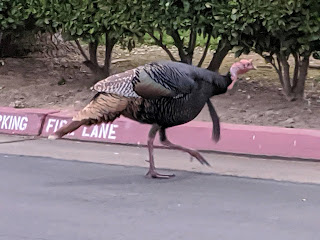 |
| Frank the Turkey by Larissa Lindsay (2021) |
One of my colleagues from
Paws with Cause painted this portrait of Frank the Turkey. I'm not sure how Frank wound up at an animal shelter. Unlike traditional domesticated pets, turkeys only live 3-5 years. The domestic white-feathered turkey is usually the star of the show when it comes to Thanksgiving dinner, while the more colorful wild turkey is smaller and has darker more flavorful meat. The largest domestic turkey on record weighed an amazing 86 pounds!
On our way home from Palm Springs in March 2020 we saw a couple of wild turkeys roaming around the parking lot of one of the hotels where we stayed in California. In most states it's illegal to keep wild animals in captivity as pets.
 |
The Turkeys at the Chateau de Rottembourg,
Montgeron (1877), Claude Monet |
I was surprised to find this painting of domesticated white turkeys by Impressionist Claude Monet. Although I had been to the Musee d'Orsay in Paris in May 2011, I don't recall seeing this painting there. It was one of four panels commissioned by Ernest Hoschedé, a department store magnate in Paris. Soon after, he lost his Impressionist collection to bankruptcy.
 |
| The Magpie (1868-9), Monet |
Monet's Magpie is my favorite of his paintings. I blogged about it in my January 2021 post entitled Snow Scenes in Painting and Photography. The small subject of this painting is perched atop a fence amidst this dramatically beautiful snow scene.
 |
| November First (1950), Andrew Wyeth |
In my search for other artwork of the Thanksgiving season, I happened upon this watercolor painting by Andrew Wyeth. It's representative of the time when most if not all of the leaves are gone and the weather is turning crisp and cold. You can almost feel the wind.
 |
| The Potato Eaters (1885), Van Gogh |
Although Van Gogh's The Potato Eaters is not a Thanksgiving painting per-se, I include it here as a fine example of people giving thanks for what they have. I appreciate his treatment of light and minimal color palette. Although dark and predominantly green and black, you can still feel the warm glow on the peasants' faces provided from a single light source.
 |
Freedom from Want (1942),
Norman Rockwell |
I want to end this post with the classic American Thanksgiving feast portrayed by Norman Rockwell in one of his Four Freedoms paintings. Entitled Freedom From Want, it represents an idealized and bountiful feast being shared by friends and family. I show it in contrast to Van Gogh's meager peasant meal (above). Notice how the people around the table are yacking it up and enjoying each other's company, not noticing the entrance of main entrée. And Grandpa isn't offering to help Grandma carry the heavy turkey to the table. Rockwell does an amazing job of capturing the white-on-white of the china, glassware, and tablecloth.






















